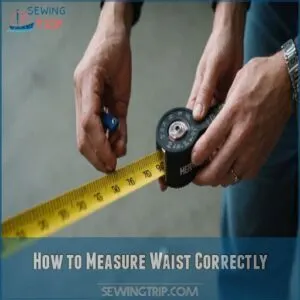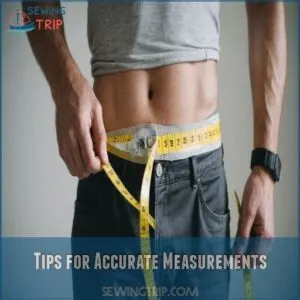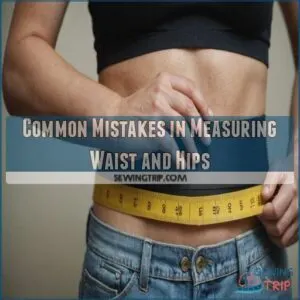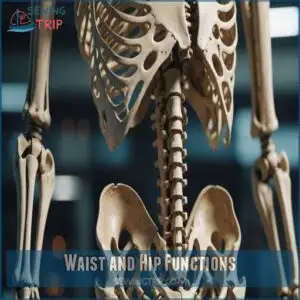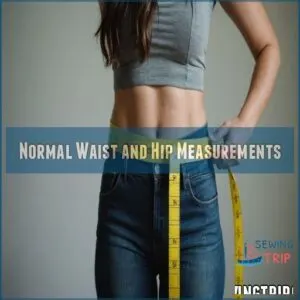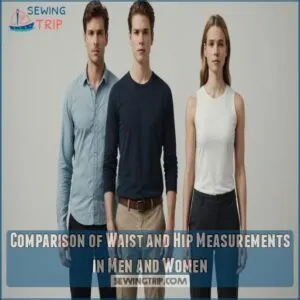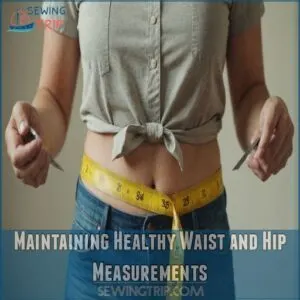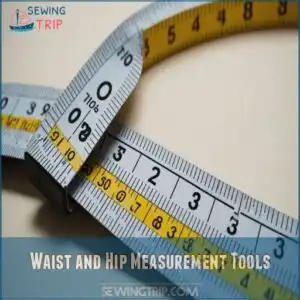This site is supported by our readers. We may earn a commission, at no cost to you, if you purchase through links.
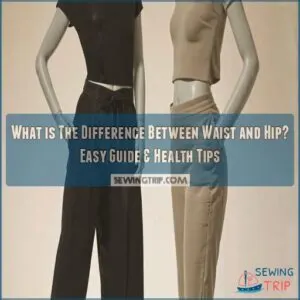
Your waist is that narrowest part of your torso, usually above the belly button.
Imagine where your belt would snugly fit; that’s your waist.
Your hips, on the other hand, make up the widest part of your lower body, involving the pelvic bones.
Think about where your favorite jeans sit comfortably; that’s likely your hips.
Knowing these differences helps in picking the perfect outfit but also in keeping tabs on your health.
Explore more intriguing insights about how this affects your body!
Table Of Contents
- Key Takeaways
- Waist and Hip Defined
- Measuring Waist and Hips
- Waist to Hip Ratio
- Waist and Hip Functions
- Hips and Waist in Body Shape
- Hip and Waist Measurement Comparisons
- Health Risks and Waist to Hip Ratio
- Maintaining Healthy Waist and Hip Measurements
- Waist and Hip Measurement Tools
- Frequently Asked Questions (FAQs)
- Conclusion
Key Takeaways
- Your waist is the narrowest part of your torso, typically above the belly button, while your hips are the widest part around your pelvic bones.
- Waist measurements are crucial for understanding body composition and health, whereas hip measurements help determine clothing size and support body mobility.
- A healthy waist-to-hip ratio is significant for assessing health risks; a higher ratio might indicate an increased risk for chronic diseases like diabetes and heart issues.
- Knowing the distinction between waist and hip not only aids in choosing the right clothing fit but also provides insights into your overall health and fitness goals.
Waist and Hip Defined
You’ve probably heard about waist and hips, but do you know what they really mean for your body?
Let’s explore these key body areas and why they’re important for your health and clothing fit.
What is Waist?
Your waist is the narrowest part of your torso, typically above your belly button and below your rib cage. It’s where you’d naturally wear a belt.
Waist circumference is a key body measurement that can indicate overall health.
When you measure your waist size, you’re getting valuable info about your body composition.
A trim waistline isn’t just about looks—it’s a sign of good health.
What is Hip?
Now, let’s talk about hips. Unlike the waist, hips are the widest part of your lower body. They’re like the foundation of your figure, supporting your weight and helping you move. Here’s what you need to know about hips:
- They’re located around your pelvic area
- Hips play a key role in walking and running
- They’re often used to determine clothing sizes
- Hip measurements can indicate overall health
- Stronger hips can improve balance and stability
Understanding your hip anatomy can help you maintain better hip health and prevent hip pain.
Key Differences Between Waist and Hip
Let’s break down the key differences between your waist and hips.
While they’re close neighbors on your body, they’ve got distinct roles to play.
Check out this handy comparison:
| Feature | Waist | Hips |
|---|---|---|
| Location | Above belly button | Around pelvic bone |
| Shape | Typically narrower | Usually wider |
| Clothing fit | Affects shirts, dresses | Determines pants size |
| Fat distribution | Central fat storage | Lower body fat storage |
Understanding these differences helps you nail your clothing fit and keep tabs on your body shape.
It’s like having a personal body map!
Waist and Hip in Body Anatomy
In terms of body anatomy, your waist and hips play distinct roles.
Your waist, the narrowest part of your torso, sits between your ribcage and hips.
It’s where you bend and twist.
Your hips, wider and lower, include your pelvis and buttocks.
They support your weight and help you move.
Together, these areas shape your body’s silhouette and influence your overall health.
Importance of Waist and Hip Measurements
Your waist and hip measurements are more than just numbers on a tape.
They’re like a crystal ball for your health, giving you a sneak peek into potential risks.
By keeping tabs on these measurements, you’re taking charge of your body shape and image.
It’s not just about fitting into those skinny jeans; it’s about understanding your fitness goals and overall well-being.
So, grab that tape measure and get to know your body better!
Measuring Waist and Hips
You’ll need to measure your waist and hips correctly to get an accurate picture of your body shape and health risks.
To take accurate body measurements, first consider the importance of pattern ease and fabric stretch, which can greatly impact your results. Let’s explore how to take these measurements properly and avoid common mistakes that could throw off your results.
How to Measure Waist Correctly
A flexible tape measure becomes your trusty companion for accurate waist measurements.
Stand tall in front of a mirror, maintaining good posture with feet shoulder-width apart.
Take a natural breath, then find the narrowest point between your ribs and hip bones, ideally your natural waistline reference.
Wrap the tape measure snugly but not tight, keeping it parallel to the floor.
Double-check the measurement for accuracy.
How to Measure Hip Circumference
Taking accurate hip measurements starts with standing in front of a mirror.
Locate the widest part of your buttocks, usually about 8 inches below your waist.
Wrap a flexible measuring tape around this fullest part of your pelvic region, keeping it parallel to the floor.
Just like measuring your waistline, you’ll want the tape snug but not tight against your body.
Tips for Accurate Measurements
For spot-on measurements of your waistline and hip circumference, stand tall with both feet shoulder-width apart.
Use a flexible body measuring tape to guarantee accuracy.
Keep the tape measure snug but not tight against your skin, and maintain natural breathing.
Check your posture in a mirror while measuring to make sure the tape stays parallel to the floor.
Let’s nail those measurements –
Common Mistakes in Measuring Waist and Hips
While measuring waist and hip circumference might seem straightforward, common mistakes can throw off your results.
Let’s avoid those measurement mishaps that make you wonder if you’re doing it right.
- Don’t pull the measuring tape too tight – it should rest naturally against your skin
- Watch your tape placement – measure at the narrowest part of your waist
- Remember to account for your natural curves when taking hip measurements
Waist to Hip Ratio
You’ll find that your waist-to-hip ratio is one of the most reliable ways to check your health risks and body fat distribution.
When you compare your waist size to your hip measurement, you can quickly spot if you’re carrying too much belly fat, which matters more for your health than your overall weight.
What is Waist to Hip Ratio?
How well do you know your body’s story?
Your waist-to-hip ratio acts like a health detective, revealing clues about your overall wellness.
This simple number helps predict potential health risks and gives you insights about your body fat distribution.
| Body Shape | Ratio Range | Health Impact |
|---|---|---|
| Apple | Above 0.85 | Higher Risk |
| Balanced | 0.75-0.85 | Moderate Risk |
| Pear | Below 0.75 | Lower Risk |
It’s like your body’s personal report card, helping you make informed decisions about your health journey.
How to Calculate Waist to Hip Ratio
Getting your waist-to-hip ratio is as simple as basic math – just divide your waist measurement by your hip measurement.
To get accurate measurements, refer to a detailed guide on how to take body measurements for specific tips on measuring your waist and hips, such as finding your natural waist and fullest point of the hips.
Here’s what you’ll need to calculate accurately:
- A flexible measuring tape placed snug
Interpreting Waist to Hip Ratio Results
Let’s take a closer look at understanding your waist-to-hip ratio results.
This handy number gives you a snapshot of your body fat distribution.
You can find a helpful waist-to-hip ratio calculator here to get a more precise understanding of your results.
Here’s a quick guide to interpreting your results:
| Gender | Low Risk | Moderate Risk | High Risk |
|---|---|---|---|
| Women | [0.80 | 0.80-0.84 | ]0.85 |
| Men | [0.95 | 0.95-0.99 | ]1.00 |
Remember, these numbers aren’t set in stone.
They’re just guidelines to help you gauge your overall health.
Your lifestyle and other factors play a big role too.
Health Risks Associated With Waist to Hip Ratio
Your waist-to-hip ratio isn’t just a number—it’s a crystal ball for your health.
A higher ratio means you’re carrying extra weight around your middle, which can spell trouble.
You’re looking at increased risks for diabetes, heart disease, and even some cancers.
It’s like your body’s sending up a red flag, saying, "Hey, time to make some changes!"
Don’t ignore it—your future self will thank you.
Waist and Hip Functions
Your waist and hips play distinct roles in your body’s function and appearance.
While your waist aids in movement and clothing fit,
your hips provide support and contribute to your overall body shape.
Function of Waist in Body Movement
Think of your waist as the body’s pivot point.
It enables you to twist, bend, and move with ease.
Your core muscles, wrapped around your waist, provide stability and power for everyday movements.
When you dance, reach for something high, or simply turn to look behind you, you’re using your waist’s flexibility.
A strong, flexible waist improves posture, balance, and overall mobility, making daily tasks a breeze.
Function of Hips in Body Support
While your waist helps you twist and turn, your hips are the unsung heroes of body support. They’re like the foundation of a house, keeping you steady and balanced. For those who need extra support, consider using a hip support belt from a trusted retailer like Every Simply hip support accessories.
Here’s how your hips work their magic:
- Hip stability: They
Role of Waist in Clothing Fitting
Let’s shift our focus from hips to your waistline, the star player in clothing fit.
It’s like the Goldilocks zone for your outfits – not too tight, not too loose, but just right.
To make sure a perfect fit, you can try some clever DIY tricks like an elastic band trick for waist tightening.
When shopping, your waist measurement is key for finding that perfect
Role of Hips in Body Proportions
Your hips aren’t just for shaking; they’re the backbone of your body’s proportions.
Hip width influences your overall shape, from pear to hourglass.
It’s not one-size-fits-all, though.
Gender differences play a big role, with women often sporting wider hips.
Your hip-to-waist ratio can impact clothing fit and even athletic performance.
So next time you’re shopping or working out, remember: your hips don’t lie about your unique body shape!
Hips and Waist in Body Shape
You’ll find that your body shape, whether apple or pear, depends on how fat gets stored around your waist and hips.
Your waist-to-hip measurements can tell you important things about your health risks and help you make better choices about diet and exercise.
Apple-Shaped Body Type
Carrying extra weight around the middle, like a ripe apple, signals an apple-shaped body type. This shape tends to store fat primarily in the waist area rather than the hips.
Regular cardio exercise and a diet rich in fiber can help manage apple-shaped health risks.
Choose clothing that flatters your shape, like A-line dresses and vertical stripes, while focusing on weight loss through core-strengthening workouts.
Pear-Shaped Body Type
Three distinctive features make a pear-shaped body type stand out: narrow shoulders, a defined waist, and fuller hips.
Women with this body shape tend to store fat below the waistline, creating an elegant hourglass silhouette.
Think of it like a juicy pear – slim at the top and naturally curvy below.
Exercise and proper nutrition help maintain this healthy shape.
- Shoulders appear narrower than hip width
- Waist curves inward naturally
- Hips and thighs create smooth curves
- Lower body appears fuller and well-proportioned
- Upper body looks slim and athletic
Impact of Waist and Hip Measurements on Body Shape
Body shape comes down to the balance between waist and hip measurements, like pieces of a puzzle fitting together.
Fat distribution patterns determine whether you’ll rock an apple or pear silhouette.
Understanding these measurements helps you choose flattering clothes and track body composition changes.
When waist size increases relative to hip size, it’s often a sign to check your lifestyle habits.
Health Risks Associated With Body Shape
Like a ticking time bomb, excess fat around your waist signals serious health risks.
If you’re apple-shaped with a high waist circumference, you’re more likely to develop metabolic syndrome and heart problems than those with pear-shaped figures.
Your hip-to-waist ratio isn’t just about looks – it’s a window into your health.
You’ll want to keep your waist size in check to dodge these complications.
Hip and Waist Measurement Comparisons
You’ll find that waist and hip measurements vary considerably between men and women, with women typically having wider hips and narrower waists.
You’ll also find that measurements will change as you age, which is why it’s important to track them and understand what’s normal for your body type and stage of life.
Normal Waist and Hip Measurements
Now that you understand different body shapes, let’s talk numbers! Your waist and hip measurements can vary based on age, gender, and ethnicity. For women aged 20-29, average waist size ranges from 28-34 inches, while hip measurements typically fall between 36-40 inches. Men in the same age group usually measure 31-38 inches at the waist and 37-42 inches at the hips.
- African and Hispanic women tend to have larger hip measurements compared to Asian women
- Most healthy adults experience a 1-2 inch increase in waist size per decade after age 40
- BMI doesn’t tell the whole story – your body frame size matters too
- Pregnancy can permanently change hip measurements by 2-4 inches
- Athletes often have larger hip measurements due to muscle mass, regardless of gender
Ideal Waist to Hip Ratio
Your waist-to-hip ratio is like your body’s secret handshake with health.
It’s a key player in understanding your overall well-being.
Let’s break it down: To get the most accurate measurements, it’s important to use a measuring tape that’s flexible and doesn’t stretch.
| Category | Ideal Ratio | Health Risk |
|---|---|---|
| Women | 0.7 or less | Low |
| Men | 0.9 or less | Low |
| Both | Over 1.0 | High |
Remember, these numbers aren’t set in stone.
They can change with age, pregnancy, and lifestyle.
Use
Comparison of Waist and Hip Measurements in Men and Women
Men and women differ in their waist and hip measurements due to distinct body fat distribution patterns.
Women typically have wider hips and smaller waists, resulting in a curvier silhouette.
Men often carry more weight around their midsection, leading to a higher waist-to-hip ratio.
These gender differences aren’t just about appearance; they also have health implications.
Understanding your body’s unique shape can help you make informed decisions about your health and lifestyle choices.
Impact of Age on Waist and Hip Measurements
As you age, your waist and hip measurements often change.
Hormonal shifts can lead to body composition changes, typically increasing waist size and decreasing hip size.
You might notice your once-hourglass figure morphing into more of an apple shape.
Lifestyle factors play a role too – less activity and muscle loss can impact your measurements.
Don’t worry, though! Regular exercise and a balanced diet can help manage these age-related changes.
Health Risks and Waist to Hip Ratio
Your waist-to-hip ratio is more than just a number; it’s a key indicator of your health risks.
A higher ratio can signal an increased chance of heart disease and other chronic conditions, making it essential to keep tabs on your measurements.
Health Risks Associated With High Waist to Hip Ratio
Those numbers we just talked about? They’re not just for show. A high waist-to-hip ratio can spell trouble for your health. It’s like carrying a ticking time bomb around your middle.
Let’s break down the risks:
- Metabolic syndrome: A cluster of conditions that increase your risk of heart disease
- Type 2 diabetes: Your body’s struggle with blood sugar control
- Obesity-related cancers: Extra weight can fuel certain types of cancer
- Sleep apnea: Breathing troubles that disrupt your beauty sleep
Tackling these risks starts with lifestyle changes. You’ve got this!
Impact of Waist to Hip Ratio on Heart Health
Your waist-to-hip ratio isn’t just about looks—it’s a window into your heart health.
Carrying extra weight around your middle, like a spare tire, can put your ticker at risk.
A higher ratio often means more belly fat, which can lead to inflammation and strain on your heart.
Keep an eye on your measurements; they’re like a personal health compass guiding you toward a happier heart.
Relationship Between Waist to Hip Ratio and Chronic Diseases
The waist-to-hip ratio tightrope walk can impact your health big time.
A higher ratio often signals increased risk for chronic diseases like diabetes and heart problems.
It’s all about where you store fat – around your waist is riskier than your hips.
But don’t fret! By tweaking your lifestyle, you can improve this ratio and lower your health risks.
Remember, small changes can lead to big wins for your well-being.
Maintaining Healthy Waist and Hip Measurements
You can maintain healthy waist and hip measurements through simple lifestyle changes and targeted exercises.
By monitoring your measurements regularly, you’ll stay on track with your health goals and reduce your risk of related health issues.
Tips for Reducing Waist Size
Reducing waist size isn’t just about looking good—though who doesn’t love a svelte figure?
Consider incorporating these tips into your daily life:
- Healthy Diet: Opt for whole foods and control portions.
- Exercise Routine: Regular cardio helps burn belly fat.
- Stress Management: Keep cortisol in check with relaxation techniques.
These changes can’t hurt, right?
Exercises for Strengthening Hip Muscles
Working on your hip muscles can be a game-changer for overall strength.
Hip flexor stretches and strengthening workouts, like lunges and clamshells, keep your hips active and pain-free.
Tackling any hip weaknesses also boosts mobility but also complements your waist strength.
Try a regular hip mobility routine for lasting hip pain relief and enhanced performance.
Importance of Healthy Lifestyle Choices
Imagine juggling your schedule to fit in a jog, preparing a nutritious meal, or slipping into deep sleep.
Making healthy lifestyle choices isn’t just a chore; it’s a lifeline for maintaining ideal waist and hip measurements.
By managing stress and building good habits, you safeguard against obesity and other health conditions, giving yourself the gift of well-being.
Monitoring Waist and Hip Measurements for Health
Healthy lifestyle choices naturally encourage monitoring waist and hip measurements, a key step in understanding your body.
Tracking these measurements provides insight into waist-to-hip ratio trends and potential health indicators.
Measuring accurately helps you notice changes in body shape, influenced by weight loss or other factors.
Keep a measuring tape handy to maintain your health, just like a trusty sidekick.
Waist and Hip Measurement Tools
Getting accurate body measurements is key, right? You’ve got options regarding waist and hip measuring tools. A simple tape measure, readily available and cheap, provides basic accuracy.
More advanced tools offer digital readouts, sometimes even calculating your waist-to-hip ratio automatically. Consider features like flexibility and ease of use. Think about cost versus the accuracy you need. Online comparisons help you find the best fit for your needs.
Remember, consistency is more important than the specific tool; use the same method each time for reliable tracking of your body measurements. Understanding your waist and hip measurements is a powerful tool for managing your health and fitness journey. Don’t underestimate the value of regular measurement in monitoring your progress and making informed decisions about your well-being. You’ve got this!
Frequently Asked Questions (FAQs)
What is the difference between waist and hip measurements?
Your waist measurement is taken at its narrowest point between your rib cage and hips.
Your hip measurement is at the widest part of your buttocks.
These are essential for understanding body shape and clothing fit.
What is arthritis in the hip?
Think of your hip as a rusty hinge; osteoarthritis wears down cartilage, causing pain and stiffness.
Inflammation leads to discomfort, especially during movement.
It often occurs with age, joint damage, or obesity, impacting daily life and activity.
What is the function of waist compared to hips?
The waist acts as a flexible connector, letting your upper and lower body twist and move smoothly.
The waist is a key part of body mechanics.
Your hips provide stability and support, essential for movement and bearing weight.
Are hips & waists related?
They’re both body parts, but located differently.
Your waist‘s the narrowest part of your torso, while your hips are wider, around your pelvic bone.
They’re related in that they’re both involved in your overall body shape and measurements.
Should my waist be smaller than my hips?
Isn’t it curious how body shapes vary?
Yes, your waist should be smaller than your hips for a healthy, balanced silhouette.
This ratio often indicates good health and lowers risks for issues like heart disease and diabetes.
What does a high hip & waist measurement mean?
When your hip and waist measurements are high, it often means there’s extra fat around your middle.
This can boost the risk of heart disease, diabetes, and other health issues, so it’s smart to keep an eye on it.
Which part is hip and waist?
Your hips are the widest part around your buttocks and pelvic area.
Waist
The waist is the narrow strip between your ribs and hips.
Think of your waist as the middle bend and your hips as the wide support.
Are hip and waist the same thing?
Hip and waist aren’t the same thing.
Your hips are around the widest part of your buttocks, supporting movement.
Your waist is the narrower area between your ribs and hips, important for body proportions and clothing fit.
What is the difference between waist and hip inches?
Think of waist and hip inches like two puzzle pieces.
Your waist is the narrow spot above your belly button, while hips span the widest part around your buttocks.
Both play critical roles in your clothing fit and health.
What is bigger, the waist or the hip?
Usually, your hips are bigger than your waist.
The waist is the narrowest part of your torso, while the hips include the widest part around the buttocks.
So, hips generally have a larger circumference than the waist.
How do waist and hip measurements affect posture?
Your waist-to-hip ratio influences your center of gravity. A larger waist can shift your balance, impacting posture. Maintaining a healthy ratio helps you stand taller and straighter!
Can genetics influence waist and hip shape?
Imagine genes as artists painting your shape.
They play a big role in determining your waist and hip size, affecting where your body stores fat.
So, don’t blame yourself entirely; your DNA’s got its brushstrokes too!
What cultural differences exist in waist-hip aesthetics?
Cultural differences in waist-hip aesthetics are fascinating.
In some cultures, a curvier figure is celebrated, while others prefer a slimmer silhouette.
Western ideals often favor an hourglass shape, emphasizing proportional hips and waist, influencing fashion and beauty standards.
Is waist size important for athletic performance?
You might think waist size doesn’t matter much in sports, yet it affects balance and core strength.
Athletes often excel with a balanced waistline, enhancing agility and endurance.
Think of it as your body’s central command!
How does aging affect waist and hip proportions?
Aging often redistributes body fat, increasing waist circumference while hips might retain or lose volume.
Hormonal changes and muscle loss contribute, affecting your waist-to-hip ratio and potentially increasing health risks.
Keep active and eat wisely to manage changes.
Conclusion
Imagine how much easier shopping and health check-ins become when you know the difference between your waist and hip!
Getting these measurements right isn’t just about picking the perfect jeans or dress.
It’s about understanding body shape, health risks, and achieving a balanced look.
Your waist and hip play key roles in health monitoring.
So next time someone asks, confidently share your insights on what is the difference between waist and hip, and impress them with your know-how!

